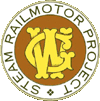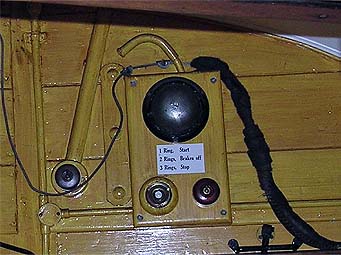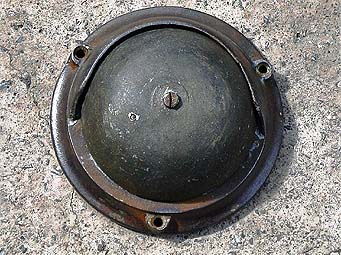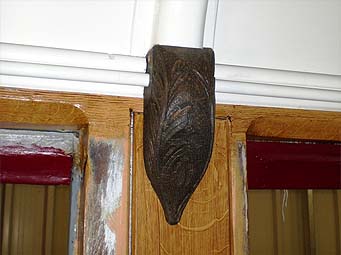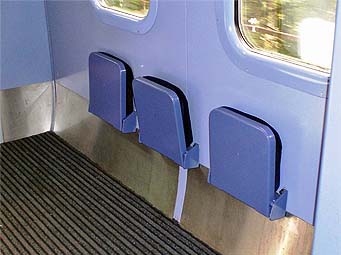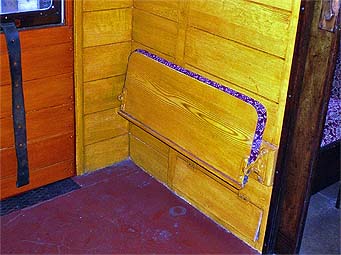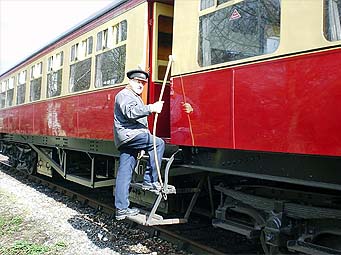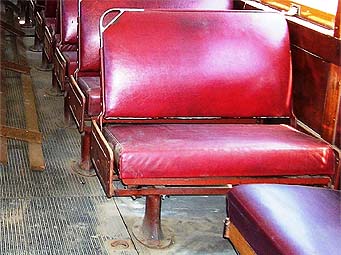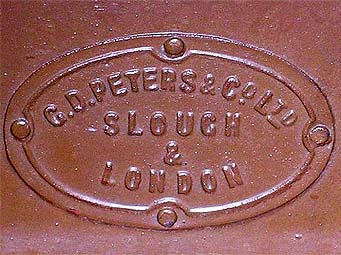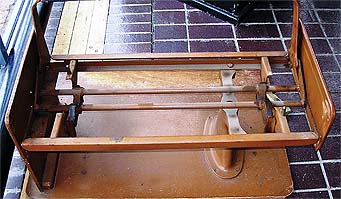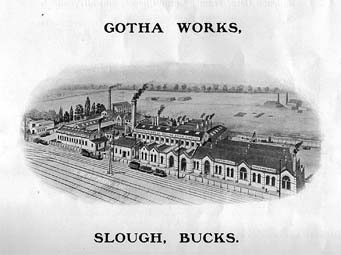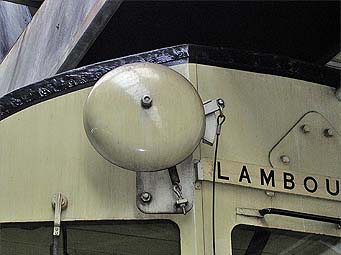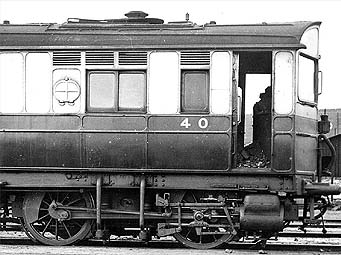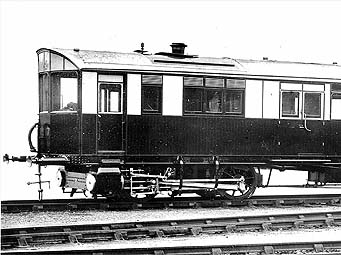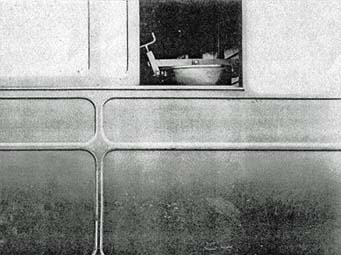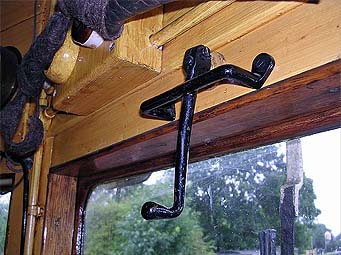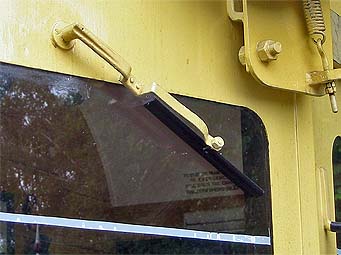Fascinating Features
The Great Western railmotors had many fascinating and unusual features, some of which were also used on the subsequent autotrailers, but are not otherwise found in Great Western carriage design.
These features include:
- Bell (Electric)
- Corbels
- Drop Seats
- Handbrakes
- Retractable Steps
- Signs and Notices
- Walk-Over Seats
- Warning Gongs
- Water Fillers
- Windscreen Wipers
Bell (Electric)
To enable the Guard to communicate with the driver and fireman an electric bell system was provided, with push – buttons and bells in the Driver‘s vestibule and the Motor compartment, and a button in the Passenger vestibule. Power was provided by a battery located in the Motor compartment, and a jumper cable and plug were provided on the trailing end of the Railmotor to connect to a similar system on an Autotrailer when this was coupled to the Railmotor. This cable was provided with a stowage socket located below the end window on the left side of the Railmotor, but most photographic evidence shows the cable left hanging below the buffer and ‘swinging in the breeze’.
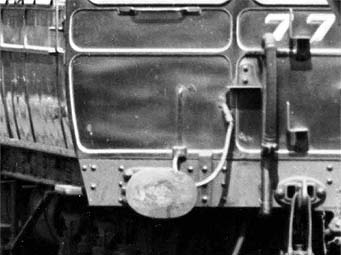
Bell codes originally were One ring to start, Two rings to stop, and Three rings to release the brakes, but were altered in 1936 to those shown in the photograph, which was taken in the Society‘s Autotrailer 190. An example of the original cast iron sign that was attached adjacent to the bell and push button is shown in the ‘Signs & Notices’ feature of this section.
Corbels
In marked contrast to the rather austere and functional interior of the vehicles, the GWR added just a hint of luxury in the form of hand carved corbels attached to the ends of the main roof hoops in the passenger saloons.
These corbels would have been more appropriate in coaches such as the ‘Dreadnoughts’ or ‘Super Saloons’.
None of these corbels seemed to have survived into preservation, and the photo shows our best guess of how they looked based on available photographic evidence.
Drop Seats
You may have thought when travelling in a British Railways Mark 3 coach that the small tip up seats, for use by passengers, situated in the coach vestibules were a good idea, and were the result of a brain-wave by some ‘switched on’ person in the design department. The picture on the left shows this type of seat fitted to a First Great Western coach kitted out in c.2006/7 specification. Yes the shocking blue is real – not computer enhanced!
To prove that nothing is new, and that the Great Western did it first, the photograph on the right shows the same concept in the luggage compartment of a GWR Autocoach. These seats, although designed only to be used when the coaches were carrying a full passenger load were nevertheless included in the vehicle carrying capacity and were officially known as ‘Drop Seats’. As far as is known this type of seat was fitted by the GWR only in Rail motors and Auto Trailers and was first used in 1904.
Handbrakes
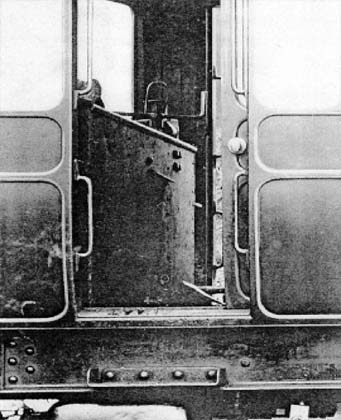
As far as is known Railmotors (and Diesel Railcars) were unique on the GWR, being the only vehicles fitted with two independently operated handbrakes.
One was located (as you would expect) in the trailing driving compartment, but the other was in a bizarre location, being placed within the coal bunker in the boiler compartment.
It is suspected that this brake was not used in day-to-day operation, as it would have been covered by coal for most of the time - It was normal practice to load coal as high as possible in the bunker, thus covering the handle.
Retractable Steps
Railmotors and autotrailers were fitted with retractable steps on both sides of the vehicle to provide passengers with easy access from rail level haults (stations) on the Stroud Valley and other lines where no raised platforms were provided.
They were situated below the passenger vestibule doors, and were operated by the guard pulling a lever inside the coach. This action swung the steps outwards from under the coach to a position away from the coach body. An additional step was fixed to the solebar immediately under the door. The linkage was so arranged that the treads on the retractable steps always remained horizontal. A pair of brass handrails, attached to the coach body at the top, and the step mechanism at the bottom assisted passengers ascend the three rather steep steps into the coach from ground level.
The arrangement can be seen on the photograph, and it will be noted that the steps, when extended, would be prone to damage from colliding with structures such as platforms at conventional stations. The train guard always had to be alert, and retract the steps as soon as the train had departed from the hault.
Signs and Notices
Various signs and notices were fixed to the interior of Railmotors and Autotrailers, some for passenger information and some for instructing the crew. A number of examples are shown below
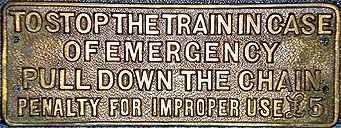
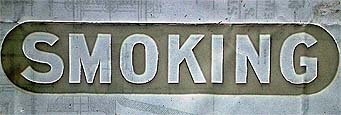
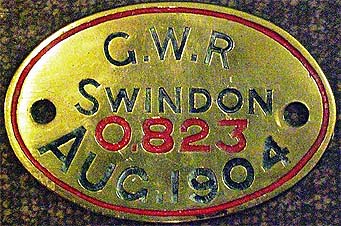
Didcot‘s new bogie will carry the next number in the series – 0913
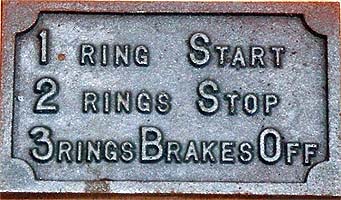
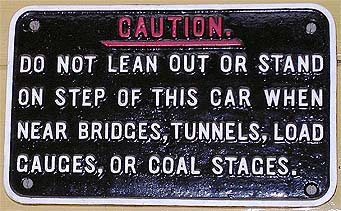
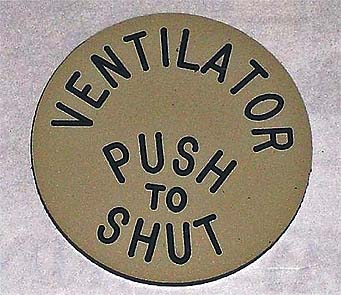
Walk-Over Seats
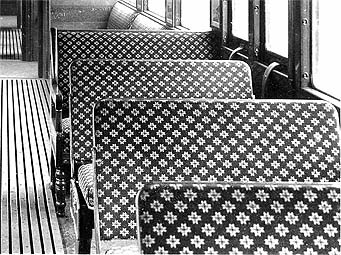
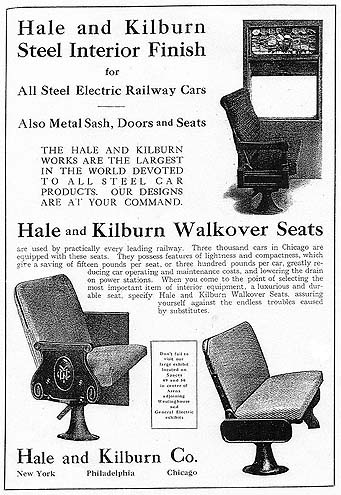
One of the remarkable features of interiors of Railmotors and early Autotrailers was the installation of seating with movable backs that allowed passengers (if they wished) to always face in the direction of travel. This style of seat was more commonly found in tramcars of the period, and as far as is known was not fitted to any other passenger carrying vehicles manufactured by the GWR.
The style of seat fitted by the GWR was designed by Henry Safford Hale of North 6th Street, Philadelphia USA, and was patented by him under patents 3478 (1902) and 5957 (1905) They were manufactured in the USA by Hale & Kilburn who had works in Chicago and New York as well as Philadelphia.
The seats were also manufactured in the U.K. by G.D. Peters & Co. who’s works stood alongside the GWR main line at Slough. – The site was rail connected, and delivery of seats to Swindon would have been an easy matter.
Peter & Co seats were exported all over the world, and some ended up being fitted to rail vehicles in Australia, eventually being repatriated by the Society for use on the Railmotor Project – see July 2006 news item
Warning Gongs
Steam Railmotors were originally just fitted with conventional whistles at the power end of the vehicle. However it was soon judged that this was inadequate when the vehicle was travelling with the power end at the rear.
To overcome the problem a large warning gong was fitted to the trailing end. This was placed above the left hand end window, when viewed externally, and was operated by a foot pedal in the Driver’s vestibule.
A similar arrangement was fitted to the driving end of autotrailers as an original feature. The photograph shows the gong fitted to Didcot’s Autotrailer Number 190.
Water Fillers
The early railmotors replenished their water tanks via a filler pipe fitted behind a sliding window within the motor compartment .
This arrangement proved to be unsatisfactory as the filling hose had to be passed through the open window into the pipe.
The arrangement was modified by fitting a swept bend to the pipe terminating at a hinged cover fitted externally to the coach side. Early railmotors were modified, and later ones built with this arrangement from new.
The photographs show both the original and modified arrangements. Didcot’s Number 93 was built with the modified system from new.
Windscreen Wipers
The rail motor and autotrailer driver has to see where he is going, and in rain this originally proved difficult as the coaches were not fitted with windscreen wipers.
A modification was therefore soon introduced and all vehicles were fitted with wipers at the driver’s windows. However unlike modern vehicles, these were hand operated by means of a handle situated above the window.
